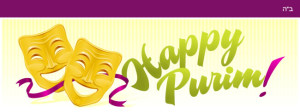On Purim Treat Yourself Like a Queen
If ever moms deserve to feel like a queen, Purim is the time to treat yourself like royalty (before some of us become slaves again and start cleaning the house of chamitz for Passover).
So grab your crown, your favorite hamantaschen, and a goblet of wine, while we uncover another layer of this joyous and mysterious Spring festival known as Purim. Purim means “feast of lots†in ancient Persian,  named since Haman had thrown lots to determine when he would carry out his scheme to wipe out the Jewish people–men, women, and children. Purim is considered the biggest party of the entire Jewish year, even rowdier than dreidel poker on Hanukkah. And yet Purim is also the holiest, even more so than the Days of Awe Rosh Hashanah and Yom Kippur. How can Purim be both? Like all Jewish holidays, Purim is another opportunity to learn about our history, better ourselves, and unite the Jewish people, but Purim goes another step and explores the mysterious hand of God at work in our everyday lives. With these four mitzvahs, Purim encourages Jews across the world to connect with each other and ourselves in the outside world, not just within the walls of our place of worship.
ONE: We read of the Megillah (book of Esther), which tells the story of the Purim miracle. This is done once on the eve of Purim and then again on the following day. During the reading, we cheer, hiss, boo, and shake our groggers and noisemakers when the good and evil characters are mentioned so that everyone is paying attention. This part of the Bible called The Writings, tells Jewish to celebrte the deliverange of the Jews of Persia with “days of feasting and gladness.”
TWO: We give money gifts, matanot la’evyonim, to at least two poor people, or a charity or cause of our choice.
THREE: We send mihloach manot, gifts to friends and family, specifically two kinds of food to at least one person.
FOUR: We go overboard on drinking, eating, dancing at the Purim feast, mishteh, so much so that we can’t tell the difference between Haman (evil) and Mordeccai (good). If ever a time that getting intoxicated is a virtue, Purim is the day because of all the LaChaims! The celebratory mood allows us to spill our deepest, truest emotions when it comes to Hashem and Torah and each other.
So while Purim makes Mardi Gras look like child’s play, depending on whose party you’re at,  there’s also something very spiritual going on. Every time we retell the Purim story we learn something new, another secret, a deeper meaning about how Queen Esther secretly collaborated with Mordeccai (her cousin, or uncle, and/or husband?) to interfere with Haman’s plan to kill all Jewish men, women, and children. The intricate plots of how this young Jewish heroien cleverly used her brains, beauty, and bravery to scheme the most powerful leader in Persia and save the entire Jewish nation is nothing short of a micracle. Queen Esther invited her husband King Ahasuerus and Haman (one of Ahasuerus’ ministers who was promoted to the position of Prime Minister) to a private dinner party at which time she revealed how arrogant Haman intended to kill Mordeccai because he refused to bow down to him. And the rest is well, history.  The twists and turns in this saga raises many questions, incuding why is God’s name, Hashem, never mentioned in the Megillah even though miracles took place that only God could pull off?  When Mordeccai asked Esther to marry the King for a purpose, even though she didn’t love Ahasuerus  and her life would be in danger, Mordeccari must have trusted that there is a God and either way the lives of the Jewish people would be spared, whether she chose to marry him or not. The mysterious hand of God is at work here, but never revealed, much the way God is present in our everyday lives even in times of conflict and despair.
Things are not always what they appear to be in this ancient story of Purim, and this theme applies to our modern lives as well. At Purim we wear costumes and pretend to be different characters, which reminds us that we all wear masks and cover our true selves. Â All of us, especially women, have an opportunity to embrace our inner beauty, speak up for what is right, and be a voice for those who are suppressed the way rightous Queen Esther played her part.
More interesting themes on Purim right HERE!
Chag Purim Sameach–have a happy Purim celebration by revealing your the real YOU!

